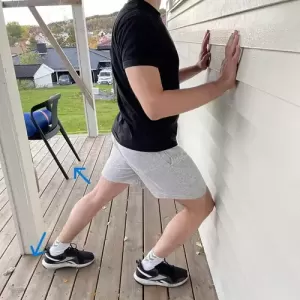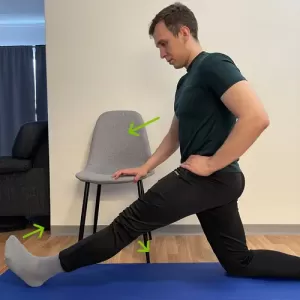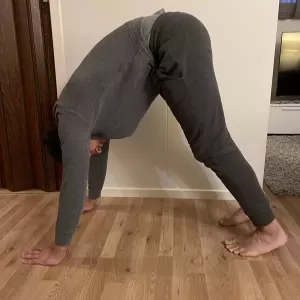The Gastrocnemius Stretch: A Comprehensive Guide
Are you looking to improve your athletic performance or to relieve calf muscle tightness?
Then you need to know how to stretch gastrocnemius muscle!
Let me show you the most effective stretches for muscle in the back of your lower leg, known as the gastrocnemius.
Stretching Exercises For Gastrocnemius
Here are 5 easy-to-follow stretching exercises that targets calf muscle gastrocnemius:
Standing Wall Gastrocnemius Stretch
Place your hands against a wall, while standing with one foot behind the other.
Keep both feet flat on the ground, and press your heel down towards the floor. Hold for 30 seconds and repeat on the other leg.
Kneeling Gastrocnemius Stretch
Kneel on one leg while keeping the other leg straight. Use a chair to hold the balance of your body easily.
Then, lean forward with your upper body while keeping your toes toward your body (ankle dorsiflexion and toes extension).
Press down with your knee to increase the stretch of gastrocnemius even more. Hold for 30s.
“Reverse V” Gastrocnemius Stretch
Place both hands and feet on the ground (like in a push-up position), and lift gently your hips up. Hold your heels on the ground all the time. Stop lifting your hips when you feel stretching in calf muscles and hold for 30s. Hold your knees straight.
Gastrocnemius Stretch With Strap
Sit on a chair and extend one leg in knee and pull your toes toward your body.
Wrap the stretching strap around the ball of your foot and pull gently towards your body. Hold for 30s.
Chair Gastrocnemius Stretch
Sit on a chair and extend one leg in knee and pull your toes toward your body.
Lean forward with your body while pushing down with your knee and keeping your toes extended. Hold for 30s.
Rotate your foot laterally and medially to stretch medial or lateral head of gastrocnemius muscle.
Tips for a Safe and Effective Gastrocnemius Stretch
- Keep your heel on the ground during the stretch to target the gastrocnemius muscle specifically.
- Avoid bouncing or jerking during the stretch, as this can cause injury.
- If you experience pain or discomfort during the stretch, ease off and decrease the intensity of the stretch.
- Hold the stretch for 30s and breath deeply.
Benefits of Stretching Gastrocnemius
Stretching your gastrocnemius has many benefits.
- Regular stretching will enhance athletic performance by increasing the range of motion in your ankle, which can help you run faster and jump higher.
- Stretching gastrocnemius can also relieve pain and soreness in your calf, which is common among runners and people who stand for long periods.
- These stretches will hold your gastrocnemius flexible and will keep gastrocnemius muscle away from muscle strain (pulled muscle).
- Furthermore, stretching the gastrocnemius can also help to improve circulation in the lower leg, which can help to reduce the risk of blood clots and varicose veins.
- Gastrocnemius is part of posterior chain muscles, and relieving the tension in this muscle can relieve tension in other posterior chain muscles like lower back extensors and hamstrings. As a result, you can improve your body posture.
Interesting Facts About Gastrocnemius:
- The gastrocnemius muscle is responsible for pointing your toes, which is known as plantar flexion.
- The gastrocnemius muscle is one of the strongest muscles in the body and it’s responsible for much of the force generated when we jump or run.
- This muscle is also known as the “gastroc” for short, and it’s the larger of the two muscles in the calf (the other is the soleus).
Conclusion
Stretching gastrocnemius is a simple and effective way to alleviate tightness in your lower leg and improve the flexibility of both knee and ankle. Focus on performing stretches for gastrocnemius both from standing, seated, “push-up” and kneeling position for maximal effect.
Continue reading:



